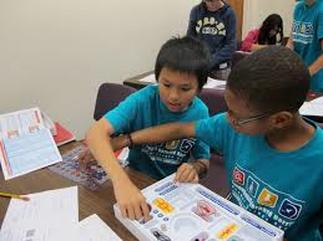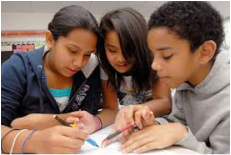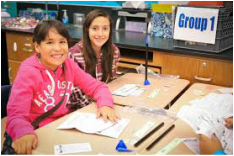6th Grade Mathematics
|
Grade 6 mathematics focuses on four critical areas:
|
Intermediate Schools (Eblen, Enka, Koontz and North Windy Ridge) and AC Reynolds MS
Parent Curriculum Materials
All of our intermediate schools and AC Reynolds high school have transitioned to a new mathematics curriculum. This curriculum is being developed and written by Illustrative Mathematics and allows us to capitalize on the one-to-one devices with a delivery through OneNote and the internet. In the coming months, ask your 6th grade student to show you their OneNote notebook on their ThinkPad. (Note: Some schools will continue to use the paper workbook through this year, it is the same materials. )
An exciting feature of these new materials are the family support materials. These materials are being written by the same writers as the teacher and student materials and provide the family a brief update of what and how your student is learning in mathematics classroom.
Currently all 6th grade students at Eblen Intermediate, Enka Intermediate, Koontz Intermediate, North Windy Ridge, and AC Reynolds Middle School are working on Geometry Standards in Unit One. By clicking on the geometry link can read the standards AND view some sample problems along with answers to work on with your student. But, read the family support materials first!
Up next in October - Ratios and the Unit Rate.
Cane Creek and Owen Middle School Curriculum Resources:
First QuarterDuring the first 9-weeks...
Students extend their previous understandings of number and operations to the full system of rational numbers (mostly in fraction form). They will expand and connect their understanding of multiplication, division, factors and multiples to:
Standards addressed: Number System:1,2,4 Ratio and Proportions:1,2,3a,b,d Expressions and Equations:1,2b,2c,3,4,6,7 |
Second QuarterDuring the second 9-weeks...
Students continue to extend their previous understandings of number and the ordering of numbers to include negative rational numbers and in particular negative integers. However, they will not perform operations with integers, but will reason about order and absolute value of rational numbers and the location of points in all four quadrants of the coordinate plane. They will also build on their work with area in elementary school by reasoning about relationships among shapes to:
Number System: 5,6,7,8 Geometry: 1,2,3,4 |
Third QuarterDuring the third nine weeks...
Students extend and connect their understandings of operations with whole numbers and fractions to decimals. It is important for students to understand why the decimal is postitioned in their answers where it is. During this time, students understand the use of variables in mathematical expressions. They
Number system: 3 Ratio and Proportions: 3c Expressions and Equations: 2a,2c,3,4,5,7,8,9 |
Fourth QuarterDuring the fourth nine weeks...
Students build on and reinforce their understanding of number, as they begin to develop their ability to think statistically. They also build on the knowledge and experiences in data analysis developed in earlier grades as they
Statistics: 1,2,3,4,5 |
The Big Ideas: Click in order to get additional information and support





